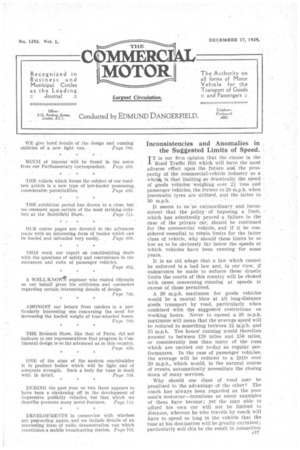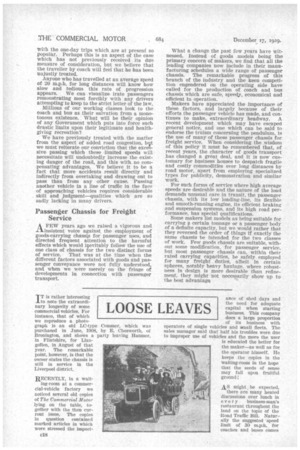Inconsistencies and. Anomalies in . : the Suggested Limits of Speed. :
Page 39

Page 40

If you've noticed an error in this article please click here to report it so we can fix it.
TT is Our firm opinion that the clause in the ; Road Traffic Bill which' Will have the most ; adverse effect upon the future and the prosperity of the commercial-Vehicle industry as a whole,' is that Jimiting.so drastically the speed : of -goods vehicles 'Weighing over 212. tons and Passenger vehieles, the' former to 20 m.p.h. when pneumatic tyres are Utillied, and the latter to 30 m.p.h. • • • -• ft seems to us 'so extraordinary, and bacon— sistent that thepolicyof imposing a limit; which has admittedly proved a failure in the case of the private • car,.should be continued for the commercial vehicle, and if it be con.siclered essential to retain limits for the latter class of vehicle, why should these limits be so low as to be obviously far below the speeds at which vehicles have been running for some years.
It is an old adage that a law which cannot be enforced is a bad law and, in our view, if endeavours be made to enforce these drastic limits the courts of this country will be choked with cases concerning running at speeds in excess of those permitted.
A.20 m.p.h. maximum for goods vehicles would be a mortal blow at all long-distance goods transport by road, particularly when combined with the suggested restrictions on working hours. Never to exceed a 20 m.p.h. maximum will mean that the average speed will be reduced to something between 12 mph. and 15 m.p.h. Ten hours' running would therefore amount to between 120 miles and 150 miles, or considerably less than many of the runs which are carried out to-day as regular performances. In the case of passenger vehicles, the average will be reduced to a little over 20 m.p.h., which would, in the natural course of events, automatically necessitate the closing down of many services.
Why should one lass of road user be penalized to the advantage of the other? The coach has always been regarded as the poor man's motorcar—luxurious as many examples of them have become; yet the man able to afford his own car will not be limited to distance, whereas he who travels by coach will have to spend so long in the vehicle that the time at his destination will be greatly curtailed ; particularly will this be the result in Connection with the one-day trips which are at present so popular. Perhaps this is an aspect of the case which has not previously received its due measure of consideration, but we believe that the traveller by coach will feel that he has been unjustly treated.
Anyone who has travelled at an average speed of 20 m.p.h. for long distances will know how slow and tedious this rate of progression appears. We can visualize irate passengers remonstrating most forcibly with any drivers attempting to keep to the strict letter of the law.
Millions of our working classes look to the coach and bus as their salvation from a monotonous existence. What will be their opinion of any Government which puts into force such drastic limits upon their legitimate and healthgiving recreation?
We have previously treated with the matter from the aspect of added road congestion, bit we must reiterate our conviction that the excessive passing which these limited speeds will necessitate will undoubtedly increase the existing danger of the road, and this with, no compensating advantages. We believe it to be a fact that more accidents result directly and indirectly from overtaking and drawing out to pass than from any other cause. Passing another vehicle in a line of traffic in the face of approaching vehicles requires considerable skill and judgment—qualities which are so sadly lacking in many drivers.
Passenger Chassis for Freight Service
AFEW years ago we raised a vigorous and insistent voice against the employment of goods-carrying chassis for passenger uses, and directed frequent attention to the harmful effects which would inevitably follow the use of one class of chassis for the two distinct forms of service. That was at the time when the different factors associated with goods and passenger conveyance were not fully understood, and when we were merely on the fringe of developments in connection with passenger transport. What a change the past few years have witnessed. Instead of goods models being the primary concern of makers, we find that all the leading companies now include in their manufacturing schedules a wide range of passenger chassis. The remarkable progress of this branch of the industry and the keen competition engendered on the operating side have called for the production of coach and bus chassis which are safe, speed.y, economical and efficient in operation.
Makers have appreciated the importance of these factors, and largely because of their efforts the passenger vehicle has made, and continues to make, extraordinary headway. A recent development which may have escaped general notice, and one which can be said to endorse the truism concerning the pendulum, is the use of many of these passenger chassis for freight service. When considering the wisdom of this policy it must be remembered that, of recent years, the character of goods transport has changed a great deal, and it is now customary for business houses to despatch fragile and costly commodities over long distances by road motor, apart from employing specialized types for publicity, demonstration and similar work.
For such forms of service where high average speeds are desirable and the nature of the load demands unusual care in transit, the passenger chassis, with its low loading-line, its flexible and smooth-running engine, its efficient braking -and suspension systems, and its high road performance, has special qualifications.
Some makers list models as being suitable for carrying a certain tonnage or a passenger body. of a definite capacity, hut we would rather that they reversed the order of things if exactly the same chassis he intended for the two classes of work. Few goods chassis are suitable, without some modification. for passenger service, but most passenger chassis can, within their rated carrying capacities, be safely employed for many freight duties, albeit in certain spheres, notably heavy haulage, where robustness in design is more desirable than refinement, they might not necessarily show up to i he best advantagq












































































































